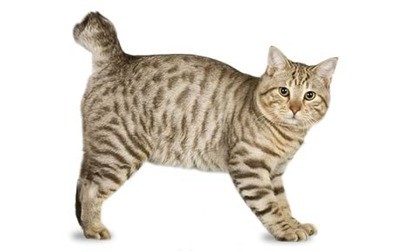Type the name of the breed you're looking for below
[wpdreams_ajaxsearchlite] Don't see the breed your're looking for? Click here and let us know!
Breed Characteristics
1 paw - breed exhibits the least amount of this characteristic
5 paws - breed exhibits most amount of this characteristic
American Bobtail
| Origin And History | Urban legend says that Bobtails are the result of a crossbreeding between a domestic tabby cat and a wild bobcat. The unusual tail is actually the result of a random spontaneous genetic mutation within the domestic cat population, and may be related to the Manx gene, which is also dominant. Yodie, a short-tailed brown tabby male, was mated with a seal-point Siamese female to create the American Bobtail's original bloodline. Most of the early bloodlines have died out. The American Bobtail developed initially through natural selection. The foundation stock for this breed were feral domestic cats possessing a natural bobtail. Experienced breeders, using found domestic bobtails from all over the United States, worked together to produce the gorgeous American Bobtails we have today. One of the more intriguing phenomena of the breed is the striking resemblance of cats with no known common heritage, from thousands of miles apart, have born to one another. By selectively breeding the like type cats, breeders have helped Mother Nature to develop the American Bobtail into the big, hearty, wild-looking bobtail cat seen today. No recognized breed of pedigreed cat has been used in the development of the American Bobtail. American Bobtails are a very strong and healthy breed, experiencing no known genetic predisposition to health problems. This cat's original appearance genetics were modified in the breed to form a new and improved strain which comes in essentially all colors and coat types. The breed was first recognized by The International Cat Association (TICA, US-based), in 1989. The breed has been accepted for championship competition by TICA, the Cat Fanciers Association (CFA, also US-based) and the American Cat Fanciers Association (ACFA). The breed is technically also sanctioned in the Cat Aficionado Association (CAA) of China, by virtue of the CAA having adopted all of ACFA's breed standards; it is unknown if any specimens are actually in China. The breed is "recognized" (as existing), as both American Bobtail Longhair and American Bobtail Shorthair, in the Germany-based World Cat Federation (WCF), but is not "accepted" for competition and has no WCF breed standard. |
| Personality | American Bobtails are loving and incredibly intelligent cats possessing a distinctive wild appearance. They are extremely interactive cats that bond with their human family with great devotion. They can both entertain through their antics at one moment and provide their owners a warm, soft shoulder to cry on in times of distress. American Bobtails are known for their love of games and can play fetch or hide and seek for hours on end. They will often initiate games with their owners, and they demonstrate their hunting instincts in the home by catching in mid-air flying insects that make the fatal mistake of entering their territory. They also love to stalk their toys and carry them in their mouths, as if they were a freshly caught rodent. Basically a quiet cat, the American Bobtail is known to trill, chirp, and click when delighted. They are easily leash trained and love to go for walks with their people. An easy going breed, they get along well with most dogs and welcome newcomers, whether they are two-legged or four-legged. |
Physical Attributes
| Appearance | The American Bobtail is hearty, short-tailed cat. Its body is moderately long, with substantial boning, and stocky. The stance is noticeably rectangular. The chest is full and broad. The hips are substantial, almost as wide as chest, and hind legs longer than fore legs with large round feet which may have toe tufts. The head is a broad wedge without flat planes, size proportionate to body. There is a concave curve from nose to brow, or rise to prominent brow, a broad unpinched muzzle, prominent whisker pads, a gently sloped wide nose and full, strong jaws. The ears are medium-sized, wide-based, and equally mounted on top and side of head with rounded tips. The eyes are almost almond shape,with size proportionate to head. The aperture is angled to base of ear, and with medium wide spacing and deep sockets. Eye color varies with coat color. The end of the tail is visible above the back, but not beyond the hock while the animal is in repose. The tail is straight or curved, slightly knotted or may have bumps. |
| Health | American Bobtails require two to three years to develop, slower than many domestic cat breeds. |



